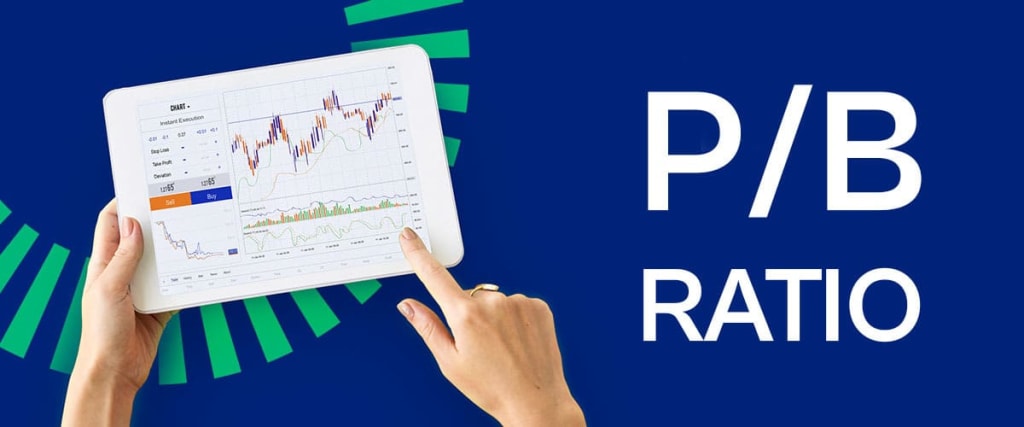Understanding the PB Ratio: A Guide for Investors
Understanding the PB Ratio: A Simple Guide for Investors.

Introduction:
When it comes to investing in the stock market, it is important to have a solid understanding of company valuations. One metric commonly used for this purpose is the price-to-book ratio, or PB ratio. In this article, we'll explore what the PB ratio is, how to calculate it, and how it can be used as a tool for investment analysis.
What is PB Ratio?
The PB ratio is a financial ratio that compares a company's current stock price to its book value per share. In other words, it shows how much investors are willing to pay for each dollar of a company's assets. Book value per share is calculated by subtracting a company's liabilities from its assets and dividing by the number of shares outstanding.
How to Calculate PB Ratio?
The formula for calculating the PB ratio is straightforward. It is calculated by dividing a company's current market price per share by its book value per share.
Book Value=Assets-Liabilities
Let's say a company has $100 million in total assets and $50 million in total liabilities. That means the company's total equity (or book value) is:
$100 million (total assets) - $50 million (total liabilities) = $50 million (total equity or book value)
PB ratio = Current market price per share / Book value per share
For example, if a company has a current market price of $50 per share and a book value per share of $10, it would have a PB ratio of 5 (50/10).
Interpretation of PB Ratio:
The PB ratio can be a useful tool for investors to evaluate the relative worth of different companies. However, it should be used in conjunction with other financial metrics and analysis in order to make informed investment decisions.
A high PB ratio may indicate that the market expects strong future growth for the company or that the company has a high return on equity. Conversely, a low PB ratio may indicate that the company is undervalued, or that the market has low expectations for future growth.
It's important to note that different industries can have different average PB ratios, so it's important to compare a company's PB ratio to its peers within the same industry.
Limitations of PB Ratio:
While the PB ratio can be a useful tool for investment analysis, it has its own limitations. One limitation is that it does not take into account a company's future growth prospects or intangible assets, such as intellectual property or brand value.
Additionally, the book value of a company's assets may not accurately reflect their true market value. For example, a company's assets may be worth more than their book value if their value has increased over time or if they have significant potential for future growth.
Summarise
When you buy things, you always want to get the best value for your money. When bigwigs buy stocks, they want to do the same thing. One way to find out whether a stock is a good value is by using a financial ratio called the price-to-book ratio, or PB ratio.
The PB ratio compares the stock price to the value of the company's assets. Assets are things that a company has, such as buildings, equipment and money in the bank. The value of the assets of a company is called the book value.
To calculate the PB ratio, you divide a company's current market price per share by its book value per share. Book value per share is calculated by dividing the total value of a company's assets by the number of shares of stock the company has issued.
PB ratio = Current market price per share / Book value per share
For example, if a company has a current market price of $50 per share and a book value per share of $10, it would have a PB ratio of 5 (50/10).
Just like with the P/E ratio, a high PB ratio does not necessarily mean that a stock is overvalued. This could mean that the market expects the company's assets to be worth more in the future. On the other hand, a low PB ratio may mean that the stock is undervalued and may be a good value.
It's also important to compare a company's PB ratio to its peers within the same industry. This can give you a better idea of how the company is performing compared to others in the same business.
The PB ratio, like all financial ratios, is just one tool that investors use to evaluate a stock. It is important to do your research and consider all factors before making an investment decision.
conclusion:
The PB ratio is a tool used to understand the value of a company's stock. It compares the company's stock price to its book value per share. Book value per share is calculated by subtracting a company's liabilities from its assets and dividing by the number of shares outstanding. A high PB ratio may mean that the company is expected to grow in the future, while a low PB ratio may mean that the company is undervalued. However, the PB ratio has limitations, such as not taking into account a company's future growth prospects or intangible assets. Investors should use the PB ratio along with other financial metrics and analysis to make informed decisions.
About the Creator
Tag Business
I Will Providing Various Company Information






Comments
There are no comments for this story
Be the first to respond and start the conversation.